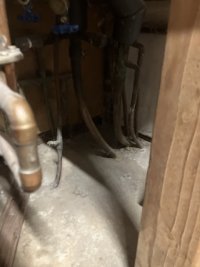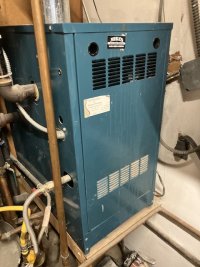You may have two heat sources. Radiant heat is typically limited to about 120 degrees or less - you wouldn't want to walk across a floor that warm or warmer...
It's a bit of a problem, since cast iron boilers have limited life spans is they're run for long periods of time at less than 140 degrees
Burnham/US Boiler cast iron boilers are rated to run with 110 degree return water for limited time periods, but have to warm up to more than that to avoid excessive condensation that can cause corrosion.
Older in-floor radiant heat was typically designed to run on higher temperatures with radiant heat loops spaced pretty far apart and buried pretty low in the slab. If your house was built in the 1960s to the 1980s, that could be your situation. Those installations would run water at higher temperatures that dissipated across the slab before reaching the feet of the occupants.
If you have access to a thermal camera, you can view the layout of the in slab tubing when the heat is one and has been running for 10 minutes or so. Modern installations are often about a foot between lines while older installations would be 3 or 4 feet.
Regardless, a good first step would be to replace the thermometer (may be a combination thermometer/pressure gauge) to be sure that's not the issue.
The boiler shouldn't let the temperature setting to be higher than 180 or 190. Even if there's a number on a dial that goes that high, the high temperature limit (a separate control) is usually fixed at 190 on those boilers.
Does the house get as warm as you need it to?


